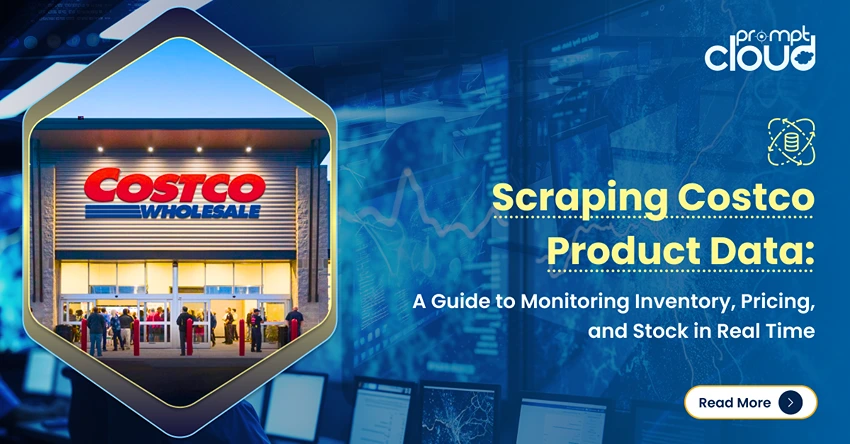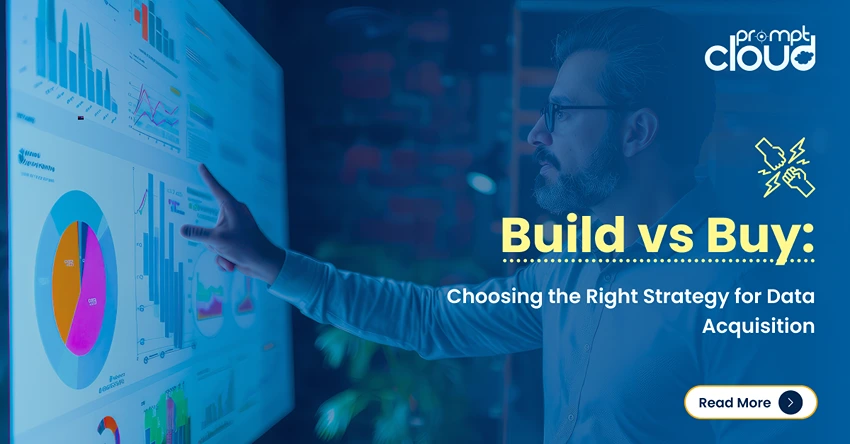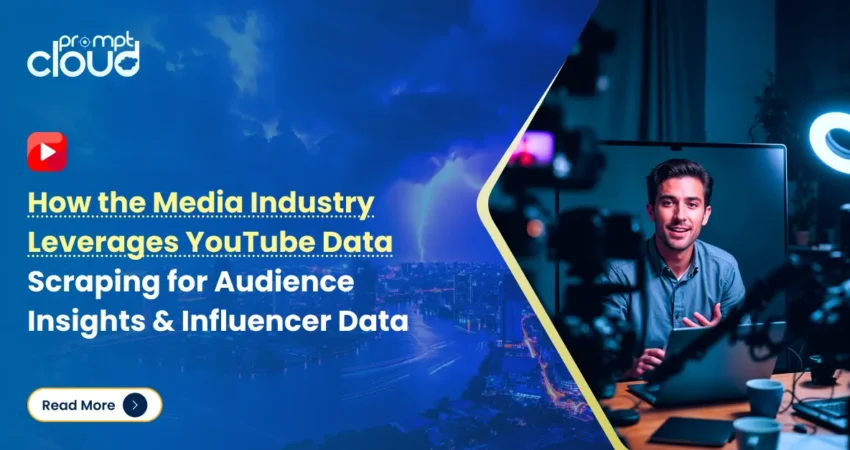
If you’re in the media business and you’re not paying attention to YouTube, you’re missing half the conversation. This isn’t just a platform where people go to watch cat videos or music clips anymore. YouTube has quietly become one of the most important sources of audience behavior, content trends, and influencer activity out there.
Think about it. Millions of videos get uploaded every day. Some take off and go viral. Others flop. Some creators build loyal followings and spark global movements. Others quietly dominate niche spaces that big media barely notices. Behind all of that? Data. Tons of it. Views, likes, comments, shares, watch time, demographics, keywords, everything a media company could ever want to know about what people are paying attention to.
That’s why media teams, from publishers and broadcasters to digital agencies, are now digging into YouTube data more seriously than ever. They want to know what works, who’s watching, and which creators are worth partnering with. The problem? YouTube doesn’t always hand over that information in a nice, neat spreadsheet.
That’s where scraping comes in. With the right YouTube data scraper, media companies can collect and organize all that raw information in a way that actually makes it useful. You get to track trends, compare creators, study audience engagement, and make smarter content and marketing decisions. And you don’t have to rely only on YouTube’s limited analytics tools to do it.
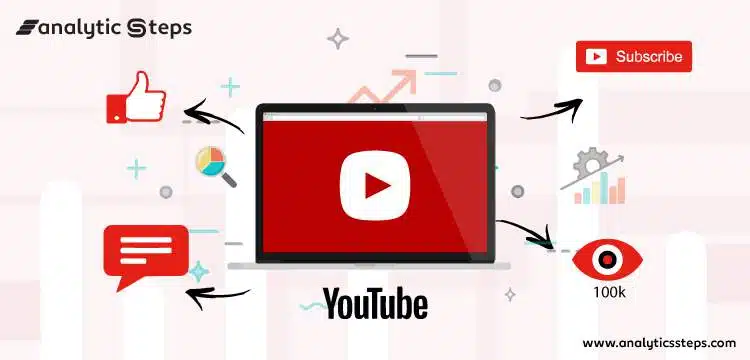
Image Source: Analytics Steps
Why Media Companies Rely on YouTube Data to Stay Ahead
There’s a reason media teams are paying close attention to what’s happening on YouTube, it’s where audiences are spending their time. Whether it’s a 30-second clip or a 45-minute docuseries, people aren’t just watching, they’re reacting, sharing, and engaging. And every click, comment, or view is a clue about what your audience actually cares about.
So what kind of insights can media companies get from YouTube data? Honestly, a lot.
You get to know your audience better.
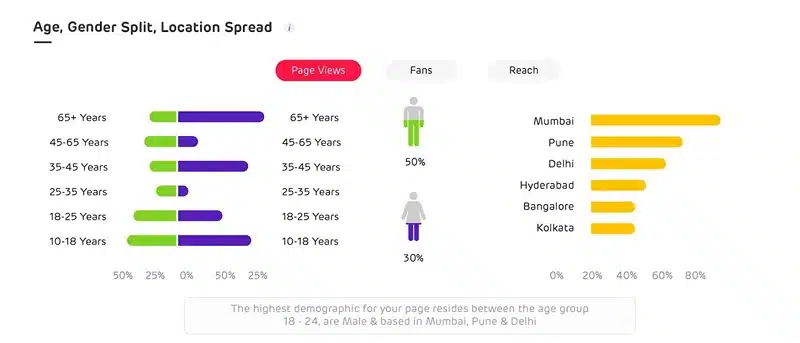
Image Source: Unbox Social
By scraping YouTube data, media teams can see who’s watching what, age groups, regions, interests, and even the time of day when engagement spikes. If your content is resonating more with Gen Z in urban areas or if you’re unexpectedly gaining traction in a niche community, this kind of information helps you shape future content and marketing strategies with real evidence.
You can follow content trends in real time.
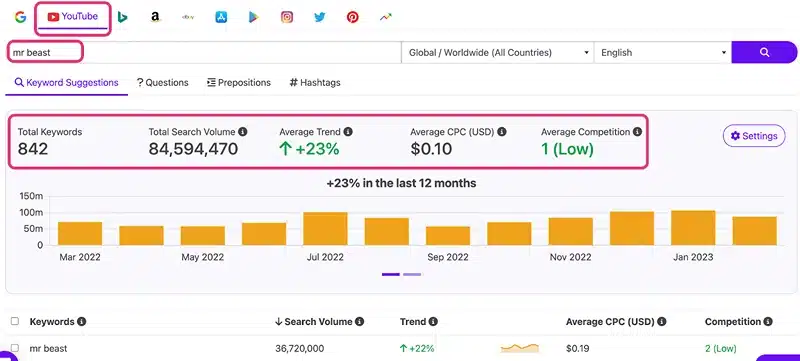
Image Source: keyword tool
Instead of playing catch-up when a video goes viral, you can spot trending topics early. By tracking popular keywords, rising creators, or spikes in engagement on certain topics, you get a front-row seat to the cultural moments that matter. That’s huge if you’re in the business of storytelling, news, or entertainment.
You can figure out which influencers actually drive engagement.
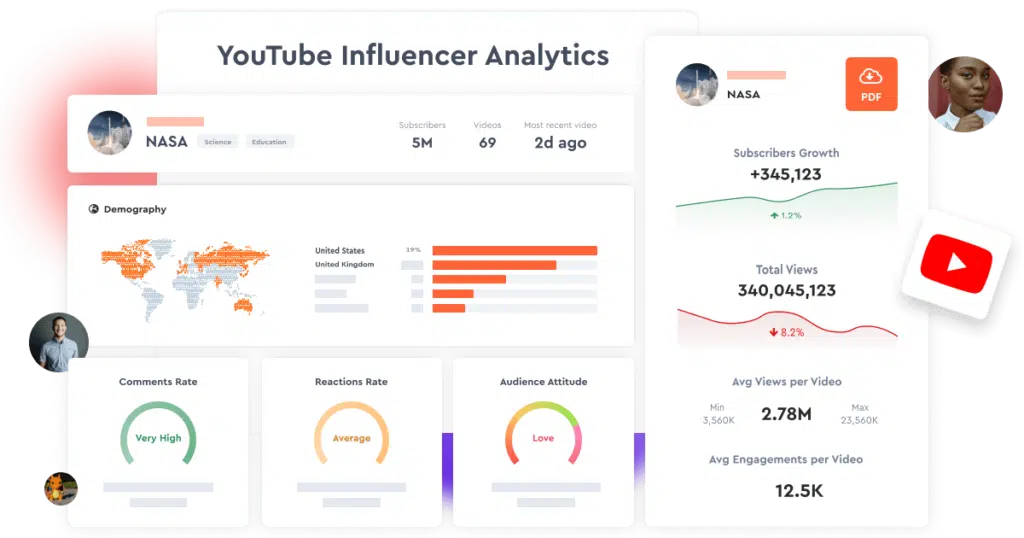
Image Source: hype auditor
This one’s big for teams doing influencer marketing. Not all creators are created equal. Two influencers might have the same follower count, but one of them drives way more comments, shares, and positive sentiment. By digging into YouTube data, media professionals can compare influencers based on actual performance, not just vanity metrics.
At the end of the day, scrape YouTube data, and you’ve got a much clearer view of what’s going on across the platform. That kind of insight is hard to come by anywhere else.
Now let’s look at how this data actually gets collected.
How a YouTube Data Scraper Works (And What It Can Actually Do)
Let’s clear something up right away- when we talk about a YouTube data scraper, we’re not talking about some shady tool hacking into the platform. Scraping, when done properly, is just a method of collecting publicly available information at scale, and turning it into structured data that’s actually useful.
So how does it work?
A YouTube crawler scans through videos, channels, playlists, or comments based on certain rules you set. Think of it like a super-speedy assistant that reads through thousands of pages and pulls out exactly what you’re looking for, except it’s automated, fast, and accurate.
Here’s the kind of data you can pull using a YouTube scraper:
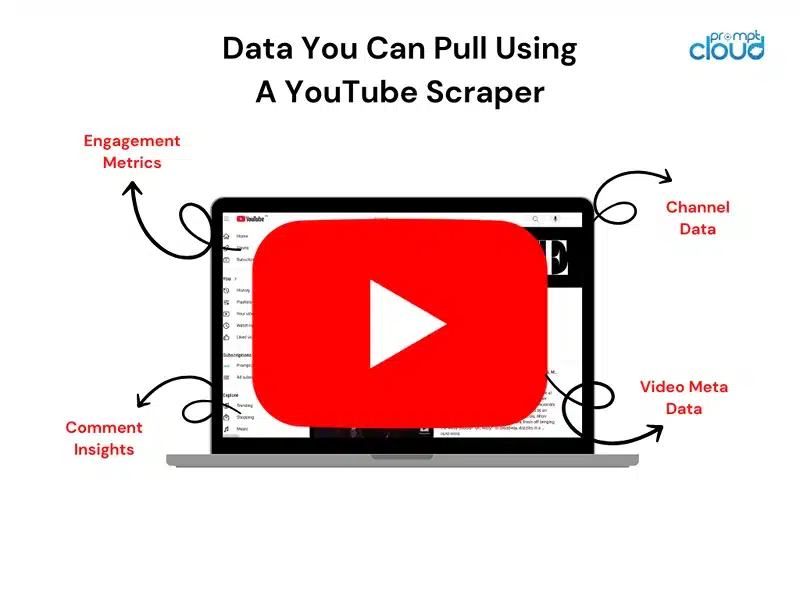
- Video metadata: Titles, descriptions, tags, upload dates, and video length.
- Engagement metrics: View counts, likes, dislikes, comments, shares, and watch time (if available).
- Comment insights: Number of comments, content of comments, sentiment trends, and keywords showing up often.
- Channel data: Subscriber counts, posting frequency, niche categories, and audience demographics.
Most YouTube scrapers work either by using the YouTube API or by scraping directly from the web. APIs can be limited; you don’t always get all the data you want, and you’re often rate-limited. Web scraping fills in those gaps, especially if you’re looking for large-scale data across hundreds or thousands of videos.
Of course, there are some ethical and legal guidelines to follow. You’re only pulling publicly available information, and it’s important to respect platform terms and avoid overloading their servers. But when it’s done responsibly, scraping is a powerful and legitimate way to unlock value from YouTube’s massive data pool.
So how do media companies actually use this in their day-to-day work?
Real-World Applications: How Media Teams Use YouTube Data
Once media companies have scraped the data, they can start using it in all kinds of smart ways. Here are a few of the most common applications.
1. Audience Analytics
This is where a lot of media strategists start. When you can break down who’s watching what, where they’re from, and how they’re interacting with content, you start to see patterns. Maybe your audience watches more short-form content on weekdays, but longer pieces over the weekend. Maybe your videos perform better when certain keywords are in the title. With enough data, you’re not guessing anymore, you’re planning based on real behavior.
2. Influencer Marketing
This is another big one. Partnering with the right creator can be a game changer, but only if you choose wisely. With scraped YouTube data, you can look at how often an influencer posts, what kind of content they make, and how their audience engages with it. You can compare performance over time and even see which campaigns led to spikes in engagement. That way, you’re not just picking someone with a big following, you’re picking someone who drives real results.
3. Competitor Tracking
You can also use a YouTube scraper to keep an eye on your competition. What types of videos are they putting out? Which ones are performing well? What’s their audience saying in the comments? All of that helps you benchmark your content and maybe even spot gaps in the market that you can jump on.
4. Ad Targeting and ROI Measurement
YouTube data can also help you figure out where your ads will land best. If you see a trend in videos or channels that align with your target audience, you can plan placements more strategically. On top of that, you can track how your ads perform across different creators or content types. Better data means better returns.
Of course, pulling all this off at scale comes with some challenges. Let’s talk about those next.
Challenges of Scraping YouTube Data (And How to Do It Right)
Scraping YouTube data sounds pretty straightforward: set up a tool, collect the data, done. But in reality, it’s a bit more complicated than that, especially when you’re working at scale or trying to stay compliant with platform rules.
Let’s start with the YouTube API.
YouTube does offer an official API, and for some use cases, it gets the job done. You can pull video metadata, channel info, and some engagement stats. But here’s the thing, it’s limited. You’re working with quotas, which means you can only make so many requests in a day. Some data points, like deeper comment insights or historical engagement trends, aren’t always available. And if you’re trying to track thousands of videos or channels? Good luck staying within the API’s limits.
That’s where web scraping comes in.
Web scraping gives you more flexibility. You’re not bound by quotas, and you can customize exactly what you want to collect, from comments and likes to video tags, upload schedules, and more. But scraping directly from the site does come with its own set of challenges.
Here are a few:
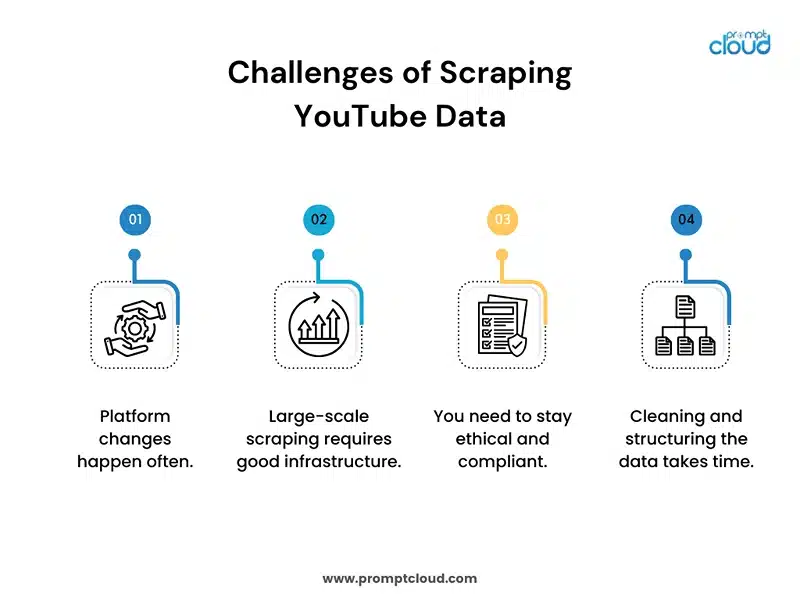
1. Platform changes happen often.
YouTube updates its layout and structure regularly. If you’re running a custom-built YouTube crawler, even small changes to the page design can break your scraper. That’s why media teams often prefer working with a scraping partner who can manage the tech side and keep everything running smoothly.
2. Large-scale scraping requires good infrastructure.
Scraping one video is easy. Scraping 10,000 videos every week? Not so much. You need systems that can handle huge volumes of requests, store and process all that data, and do it without getting blocked or throttled. This is where things like IP rotation, smart scheduling, and error handling come into play.
3. You need to stay ethical and compliant.
This is a big one. Just because data is publicly available doesn’t mean you can do whatever you want with it. Good scraping practices respect platform terms of service, avoid overwhelming servers, and focus only on non-private, public-facing content. It’s not about bypassing rules, it’s about collecting useful data responsibly.
4. Cleaning and structuring the data takes time.
Raw scraped data is messy. You’ll get duplicates, missing values, odd characters, and all kinds of inconsistencies. Before you can actually use it for audience insights or influencer research, you need to clean it up and organize it properly. This part is often underestimated but absolutely critical.
So yes, scraping YouTube data is powerful, but it also requires the right approach. That’s where a partner like PromptCloud can make a huge difference.
YouTube Data Isn’t Optional Anymore
Let’s be real, media companies can’t afford to ignore YouTube anymore. If you’re in content, marketing, or anything remotely audience-facing, YouTube is where a lot of the story is unfolding. It’s where trends take off. It’s where creators build movements. And it’s where your audience is spending a big chunk of their time.
So the question isn’t – should you be looking at YouTube data? It’s how deep you’re willing to go with it.
Scraping YouTube data gives you the kind of insights you just can’t get from basic analytics. It helps you see what’s clicking with audiences, what kind of content is making waves, and which influencers actually have an impact, not just a follower count.
And yeah, pulling that data at scale isn’t always simple. The API only gets you so far. Scraping has its quirks. And cleaning up messy data? Nobody’s idea of a good time.
But that’s where the right tools (or better yet, the right partner) can make a difference. You don’t need a massive tech team or weeks of setup to get started. You just need a clear idea of what you want to learn and a way to get the data without losing your mind.
At PromptCloud, this is the kind of stuff we do every day. No buzzwords, no drama. Just clean, customized YouTube data that helps media teams do their jobs better.If that’s something you’ve been thinking about or wrestling with, we’re here. Let’s talk.











